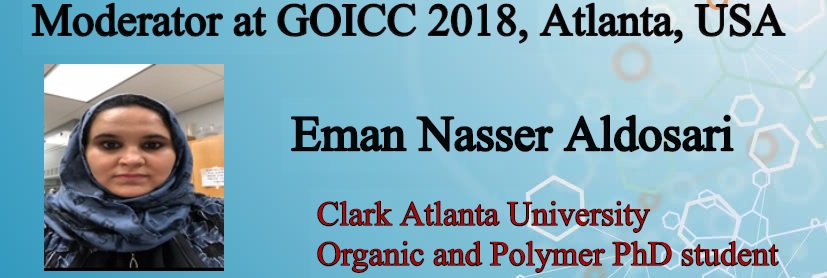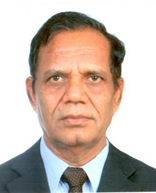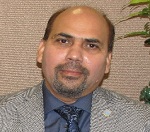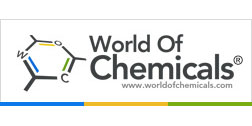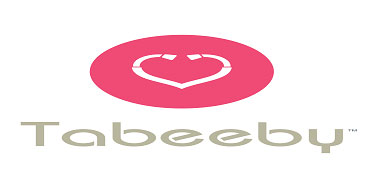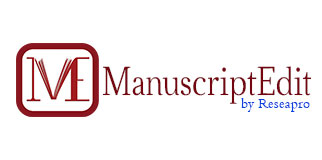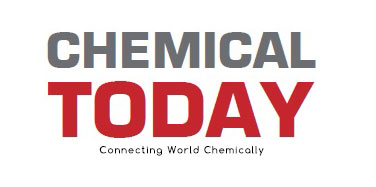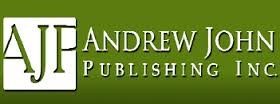Theme:
GOICC 2018
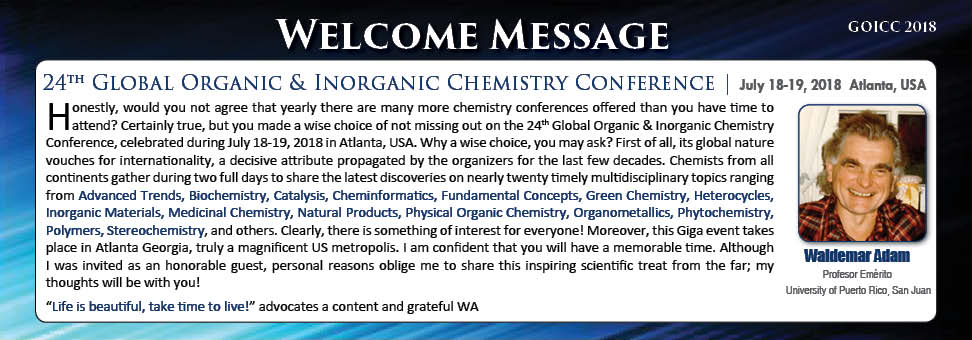


Conference Series LLC Ltd hosts 3000+ Global Events that includes over 1000+ International Conferences, 1000+ Symposiums and 1000+Workshops and preconference workshops on diverse Medical, Pharmaceutical, Clinical, Engineering, Science, Technology, Business and Management fields. Over 25 Million visitors flock to our websites to observe the attest developments in these fields.
With the amalgamation of eminent speakers of Organic & Inorganic Chemistry 2017 Conference Series LLC Ltd is privileged to announce its “24th Global Organic & Inorganic Chemistry Conference” which is going to be held during July 18-19, 2018, Atlanta, USA”. We cordially welcome all the professional chemists, life science expertise researchers, professors, scientific communities, delegates, students, business professionals and executives from all over the world to take part in this upcoming congress to witness valuable scientific discussions and contribute to the future innovations in the field of chemistry.
Organic Chemistry 2018 is a global platform to discuss and learn about new compounds and its structure, bonding, reactivity in field of organic chemistry and organometallic chemistry, organic geochemistry, biogeochemistry, marine geochemistry, petroleum geochemistry, Bioorganic and medicinal chemistry. Advancement in fields of modern experimental organic chemistry, modern analytical organic chemistry, modern theoretical organic chemistry, combinatorial Chemistry, flow chemistry, green chemistry, microwave chemistry, microwave spectroscopy, new synthetic methods and advances in catalysis
In the light of this theme, the Conference Series LLC Ltd aims to provide a forum for international researchers from various areas of chemistry, pharmacy, materials science and chemical engineering by providing a platform for critical analysis of new data, and to share latest cutting-edge research findings and results about all aspects of Organic Chemistry. The meeting will be a multidisciplinary gathering and present major areas such as organometallic, medicinal chemistry, polymer chemistry and overall applications.
Conference Series LLC Ltd organizes 1000+ Global events every year across the globe with support from 1000+ more scientific societies and Publishes 700 Open access journals which contains over 50000 eminent personalities, reputed scientists as editorial board members.
Target Audience:
Organic Chemists
Inorganic Chemists
Professors in Chemistry
Associate and Assistant Professors in Organic Chemistry
Post-doctoral and Researchers in Chemistry
Heads of Chemical Departments
Post Graduates and Graduates in Medicinal Chemistry
Laboratory Chemists
Chemical Scientists working on Materials
Experts in the development of Organometallic Chemistry
Why to Attend:
With members from around the world focused on learning about chemistry, organic and inorganic chemistry; this is your single best opportunity to reach the largest assemblage of participants. Conduct demonstrations, distribute information, meet with current and potential customers, make a splash with a new product line, and receive name recognition at this 2-day event. World renowned speakers, the most recent techniques, tactics, and the newest updates in fields are hallmarks of this conference.
Target Audience:
Directors, Presidents & CEO’s from organizations, chemical instrument vendors, Professors and Students from academia in the study of chemistry related studies, delegates from various Chemical, Pharma, Argochemicals companies from all over the world.
Global Market in Organic Chemistry
The Organic Chemical Manufacturing industry has a high level of capital intensity. For every dollar spent on labor, the industry spends an estimated $0.61 on capital, which indicates that many of the processes are automated with many of the products being mass-produced. Because of the high level of technology use, many firms operating within this industry employ fewer than 20 workers. During the recession, the industry came to rely even more heavily on capital since employment was one of the easiest places to cut costs. However, employment and wages will increase over the next five years as industry players invest more in human resources and expand their research and development teams to become more efficient and remain competitive. The Organic Chemical Manufacturing industry has rapidly expanded over the past five years. The industry, which provides raw materials to different industries, such as plastic, paint and adhesive manufacturing, is anticipated to increase strongly over the five years to 2016-17. In the coming years, Demand from key buying industries will expand, driven by higher consumer consumption and an increase in exports. The Organic Chemical Manufacturing market research report provides key industry analysis and industry statistics, measures market size, analyzes current and future industry trends and shows market share for the industry’s largest companies. IBIS World publishes the largest collection of industry reports so you can see an industry’s supply chain, economic drivers and key buyers and markets.
Organic Chemistry 2018 is an international platform for presenting research about chemistry and related fields thus contributes to the dissemination of knowledge for the benefit of both the academia and business. This event brings together the top professionals in the field along with the highly affiliated professors to explore the advancements and latest applications achieved in the field of chemistry. Global Organic & Inorganic Chemistry Conference 2018 discusses various fields of chemistry employed in theoretical, physical, organic, pharmaceutical, and life science fields which mark the support for the advanced and much needed research by their study on various topics. The scientific program will focus on current advances in the research and use of chemistry and related with particular focus on its roles and applications in various fields.
Introduction
The chemical industry creates an immense variety of products which impinge on virtually every aspect of our lives. This has brought a tremendous change in the way the things operate. It is very important for us to understand the importance of the chemical industry which has touched all our facets of life like Agriculture, Environment, Food, Hygiene, Décor, and Transportation. It has also significantly used in re-cycling industries to curb the usage of virgin products. Re-cycling helps a lot in utilizing the waste materials, and gives one more life-cycle for the products.
The industry uses a wide range of raw materials, from air and minerals to oil.
The products of the chemical industry can be divided into three categories:
- Basic chemicals
- Speciality chemicals
- Consumer chemicals
Basic chemicals
Basic chemicals are divided into
- chemicals derived from oil, known as petrochemicals
- polymers
- basic inorganics
Speciality chemicals
This category covers a wide variety of chemicals for crop protection, paints and inks, colorants (dyes and pigments). It also includes chemicals used by industries as diverse as textiles, paper and engineering.
Consumer chemicals
Consumer chemicals are sold directly to the public. They include, for example, detergents, soaps and other toiletries
How does the chemical industry contribute to an economy?
The chemical industry is a very important contributor to the wealth of a country. For example it contributes over 1% to the Gross National Product (GNP) of European countries, which is over 6% of the total GNP produced by all manufacturing industries.
What is the value of the industry geographically?
In 2011, worldwide, it was estimated that world sales of chemicals amounted to over $3500 billion.
|
Year |
2001 |
2011 |
2014 |
|
Total sales in (billion $) |
1829 |
3567 |
3555 |
|
China |
8.1 |
26.8 |
30.4 |
|
Europe (EU) |
29.8 |
19.6 |
17.0 |
|
Rest of Asia |
14.0 |
18.8 |
16.3 |
|
North America |
27.6 |
17.1 |
12.8 |
|
Japan |
10.7 |
6.4 |
4.7 |
|
South America |
4.5 |
5.5 |
4.4 |
|
Rest of World |
5.3 |
5.8 |
1.4 |
When the size of the country’s population is considered, figures varies
|
|
Sales |
Population |
Sales/per head of |
|
China |
1222 |
1382 |
884 |
|
US |
515 |
324 |
1590 |
|
Germany |
162 |
126 |
1286 |
|
Japan |
156 |
81 |
1926 |
|
South Korea |
133 |
51 |
2608 |
|
Brazil |
87 |
210 |
414 |
|
France |
87 |
65 |
1338 |
|
India |
80 |
1327 |
603 |
|
Taiwan |
77 |
23 |
3348 |
|
Italy |
57 |
60 |
950 |
|
Netherlands |
55 |
17 |
3235 |
|
United Kingdom |
44 |
65 |
677 |
|
Spain |
43 |
46 |
935 |
Research and development (R&D)
Although expensive and time-consuming, research and development is crucial to the industry’s evolution. To keep competitive the industry must:
- Find new products which enhance the quality of life
- Adapt rapidly to changes in consumer demand around the worldproduce and sell chemicals in quantities that achieve economies of scale
- Select locations for bulk chemical companies so that they can access the cheapest raw materials and energy
- Improve existing processes for making chemicals in order to use less capital expenditure and save raw materials
- find methods of manufacturing that use and dispose of chemicals which do not harm the environment
- Locate speciality chemical companies near good centres of R&D within both the commercial and university sectors.
The R & D cycle - deciding to carry out research on a particular topic, to spend money on development and then to manufacture - involves not only chemists and chemical engineers but other experts; financial (for borrowing the large sums of money needed), marketing (for ensuring that their new or improved product can be sold), legal (to ensure that the patents are secure) and many others.
The Chemical Industry: How safe and how environmentally regulated?
Safety must be at the top of the chemical industry’s agenda and for good reason. Many of its products are potentially hazardous at some stage during their manufacture and transport. These chemicals may be solids, liquids or gases, flammable, explosive, corrosive and/or toxic. Manufacturing processes frequently involve high temperatures, high pressures, and reactions which can be dangerous unless carefully controlled. Because of this the industry operates within the safety limits demanded by national and international legislation.
Global Organic Food Market by Product Type (Organic Meat, Poultry and Dairy; Organic Fruits and Vegetables; Organic Processed Food; etc.), By Region (Europe, North America, Asia-Pacific, etc.)
Global organic food market stood at $ 110.25 billion in 2016, and is projected to grow at a CAGR of 16.15%, in value terms, during 2017 – 2022, to reach $ 262.85 billion by 2022. Growing awareness regarding health benefits of organic food consumption, rising per capita spending on organic food products and increasing health concerns due to growing number of chemical poisoning cases are expected to drive global organic food market in the coming years

Global Consumption of Agricultural Fertilizer:
Fertilizers, and pesticides aids in the agriculture and development. The green revolution has happened only due to the advancement of chemical industry in India. The fertilizers and pesticides, not only increase the yield of the crop, but prevent from pest attacks. Apart from in-house usage of food products within our country, people are also exporting a lot of grains, fruits, flowers and ornamental stem to various parts of the world. The GDP of the country drastically increases with the industry. Pharma industries and lifesaving drugs are the fastest growing industry in India.
Some of the major players operating in the global organic food market are
Danone, Hain Celestial Group
EDEKA Handelsgesellschaft Nord GmbH
General Mills
SFM, LLC
United Natural Foods
Nature's Path Foods
Amy’s Kitchen
Organic Valley
Newman’s Own
Aldi Einkauf GmbH & Co hogs
REWE Markt GmbH
Hipp GmbH & Co Vertrieb KG
Clif Bar & Company
Aurora Organic Dairy
SunOpta
Stonyfield Farm
Harmony Organic
Eden Foods
Alnatura Produktions- und Handels GmbH, etc.
Why Atlanta?
Atlanta is the capital of and the most populous city in the U.S. state of Georgia, Atlanta is the cultural and economic center of the Atlanta metropolitan area. Encompassing $304 billion, the Atlanta metropolitan area is the eighth-largest economy in the country and 17th-largest in the world. Corporate operations comprise a large portion of the Atlanta’s economy, with the city serving as the regional, national, or global headquarters for many corporations. Atlanta contains the country’s third largest concentration of Fortune 500 companies, and the city is the global headquarters of corporations such as The Coca-Cola Company, The Home Depot, Delta Air Lines, AT&T Mobility, UPS, and Newell-Rubbermaid. In Atlanta, fine dining, shopping and rich history combine with inspiration inducing attractions to create a city with Southern charm and world-class sophistication. It’s easy to see why Atlanta, Georgia is one of the most popular destinations in the Southeast to live and to visit. As of 2010, Atlanta is the seventh-most visited city in the United States, with over 35 million visitors per year. Although the most popular attraction among visitors to Atlanta is the Georgia Aquarium the world’s largest indoor aquarium, Atlanta’s tourism industry mostly driven by the city’s history museums and outdoor attractions. Atlanta contains a notable amount of historical museums and sites, including the Martin Luther King, Jr. National Historic Site, which includes the preserved childhood home of Dr. Martin Luther King, Jr., as well as his final resting place; the Atlanta Cyclorama & Civil War Museum, the National Center for Civil and Human Rights, which explores the American Civil Rights Movement and its connection to contemporary human rights movements throughout the world; the Carter Center and Presidential Library, and the Margaret Mitchell House and Museum. Atlanta also contains various outdoor attractions. The Atlanta Botanical Garden, Kendeda Canopy Walk, a skywalk that allows visitors to tour one of the city’s last remaining urban forests from 40-foot-high (12 m). Zoo Atlanta accommodates over 1,300 animals representing more than 220 species. Besides those festivals showcasing arts and crafts, film, and music, including the Atlanta Dogwood Festival, the Atlanta Film Festival, and Music Midtown, respectively, is also very popular tourist’s attractions.
Major Associations & Society’s in World Wide:
Eastern Illinois University
Governors State University
University of Illinois at Chicago
University of Illinois at Springfield
Northeastern Illinois University
Northern Illinois University
Southern Illinois University Edwardsville
Western Illinois University
Department of Chemistry and Biochemistry University of Nevada, Las Vegas
Southen Nevada Local Section of the American Chemical Society
Chemistry Graduate Student Association (CGSA) Nevada, Reno
American Institute of Chemical Engineers (AIChE)
American Chemistry Council
American Institute of Chemists (AIC)
American Society for Biochemistry and Molecular Biology (ASBMB)
American Society for Mass Spectrometry (ASMS)
American Organization of Analytical Chemists (AOAC) International
Chemical Development and Marketing Association (CDMA)
American Chemical Society Division of the History of Chemistry (HIST)
Conference Series LLC Ltd hosts 3000+ Global Events that includes over 1000+ International Conferences, 1000+ Symposiums and 1000+Workshops and preconference workshops on diverse Medical, Pharmaceutical, Clinical, Engineering, Science, Technology, Business and Management fields. Over 25 Million visitors flock to our websites to observe the attest developments in these fields.
1. Fundamental Concept of Organic Chemistry
- Types and characterization of organic compounds
- Functional groups
- Aliphatic and aromatic compounds
- Heterocyclic compounds
- Nomenclature of new compounds
2. Bioorganic and Biochemistry
- Peptides sequence analysis
- Classification of amino acids
- Stereochemistry of amino acids
- Acid-Base behaviour of amino acids
- Synthesis of amino acids
- Reactions of amino acids
- Peptide structure amino acid Analysis
- Nucleosides
- Classification of carbohydrates
- Fischer projections and the DL notational system
- Aldotetroses
- Disaccharides and polysaccharides
- Epimerization and isomerizations
3. Stereochemistry of Organic Compounds
- Molecular chirality and enantiomers
- Properties of chiral molecules and optical activity
- The cahnIngoldPrelog RS notational system
- Physical properties of enantiomers
- Stereogenic center
4. Computational Chemistry and Cheminformatics
- Chemoinformatics and its applications
- Cheminformatics tools for drug discovery
- Quantitative structure activity relationship
- Bioinformatics
5. Phytochemistry and Pharmacognosy
- Natural products chemistry in drug discovery
- Isolation and structure determination of natural products
- Analysing pharmacogenomics studies
- Phytotherapy
- Herbs and botanicals as dietary supplements
- Ethnopharmacy
- Comparative phytochemistry, its history, concepts, applications and methods
6. Green Chemistry and Sustainable Technology
- Green catalysis
- Environmental Chemistry
- Green chemical solvents
- New trends in green chemistry
- Chemical risk and regulatory issues
- Human exposure and toxicity
- Polymer structure and morphology
- Polymer synthesis and polymer coating
- Enzyme kinetics and thermodynamics of enzymatic reactions
8. Bio-chemistry and agricultural chemistry
- Biochemistry and agrochemicals
- Elementary calculus
- Weed biology and control
- Biochemistry and metabolism
- Environmental management
- Standardizing analytical methods
- Equilibrium chemistry
- Gravimetric methods
- Titrimetric methods
- Spectroscopic methods
- Electrochemical methods
- Chromatographic & Electrophoretic
- Quality assurance
- Additional resources
10. Advanced Synthesis and Catalysis
- Heterogeneous catalytic process
- Catalyst formulation and preparation methods
- Catalysts characterization methods
- Mechanism of catalytic reactions
- Design of catalysts and simulation techniques
11. Physical Organic Chemistry
- Atomic theory
- Biophysical Chemistry
- Thermochemistry and quantum chemistry
- Chemical bonding, aromaticity, anti and homoaromaticity and structures
- Solvent effects and isotope effects on organic reactions
- Acidity, nucleophilicity and electrophilicity
- Equilibria
12. Natural Products and Heterocyclic Chemistry
- Chemistry and efficacy of natural products
- Safety and regulations on natural products
- Cosmeceuticals, nutraceuticals (functional foods) and beverages
- Health and beauty product development and innovation
- Methodologies for natural products
13. Flow Chemistry
- Continuous flow reactors
- Photo chemistry in combination with flow chemistry
- Electrochemistry in combination with flow chemistry
- Segmented flow chemistry
14. Medicinal Chemistry, Drug Synthesis
- Pharmaceutical Sciences
- Drug discovery
- Pharmacophore and Xenobiotic metabolism
- Pharmacognosy and Pharmacokinetics
- Pharmaceutical Industry
- Anticancer agents
- Pharmacology and toxicology
- CADD (Computer Aided Drug Design)
- Drug Design and Drug Development
- Hit to lead and lead optimization
15. Inorganic and Bioinorganic Catalysis
- Coordination Chemistry & Case Studies
- Reactions in aqueous solutions
- Organometallic chemistry
- Molecular geometry
- Ligand field theory
- Electronic configurations
- Descriptive Chemistry
- Crystal Lattices
- Crystal Field Theory
- Crystallography
16. Inorganic Materials and Nanoparticles
- Materials Science and Engineering
- Polymer technology
- Nanotechnology in material science
- Mining, Metallurgy and Materials Science
- Computational Materials Science
- Electrical, Optical and Magnetic Materials
- Organometallic nomenclature
- Carbonmetal Bonds in organometallic compounds
- Grignard reagents
- Transition metal organometallic compounds
- Carbenes and carbenoids
18. Industrial Inorganic Chemistry
- The Chemical Industry.
- Sources of Inorganic Raw Materials
- Sulfuric Acid and Sulfates
- Nitrogen Compounds
- Phosphorus Compounds
- Chlor-Alkali Compounds
- Titanium Dioxide
19. Modern Organic Chemistry and Applications
- Organic synthesis
- Development of synthetic methodologies
- Catalysis
- Natural products
- Functional organic materials
- Supramolecular and macromolecular chemistry
- Physical and computational organic chemistry
- Heterocycles
- Bioorganic Chemistry
- Organ catalysis
- Asymmetric Reactions
- Metals in Organic Chemistry
20. Advance Trends in Organic Chemistry
- Graphene
- Nanostructures from DNA building blocks
- Tuberculosis diagnostics
- Fluorination
- Pyrrolysine
- Structural biology by NMR.
Conference Highlights
- Fundamental Concept of Organic Chemistry
- Bioorganic and Biochemistry
- Stereochemistry of Organic Compounds
- Computational Chemistry and Cheminformatics
- Green Chemistry and Sustainable Technology
- Polymers and Monomers
- Bio-chemistry and agricultural chemistry
- Analytical Chemistry
- Advanced Synthesis and Catalysis
- Physical Organic Chemistry
- Natural Products and Heterocyclic Chemistry
- Flow Chemistry
- Medicinal Chemistry, Drug Synthesis
- Inorganic and Bioinorganic Catalysis
- Inorganic Materials and Nanoparticles
- Organometallic Chemistry
- Industrial Inorganic Chemistry
- Modern Organic Chemistry and Applications
- Advance Trends in Organic Chemistry
- Phytochemistry and Pharmacognosy
- Organic Photochemistry
To share your views and research, please click here to register for the Conference.
To Collaborate Scientific Professionals around the World
| Conference Date | July 18-19 , 2018 | ||
| Sponsors & Exhibitors |
|
||
| Speaker Opportunity Closed | Day 1 | Day 2 | |
| Poster Opportunity Closed | Click Here to View | ||
Useful Links
Special Issues
All accepted abstracts will be published in respective Our International Journals.
- Journal of Organic & Inorganic Chemistry
- Journal of Medicinal and Organic Chemistry
- Archives in Chemistry
Abstracts will be provided with Digital Object Identifier by


